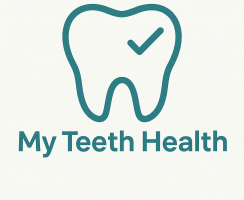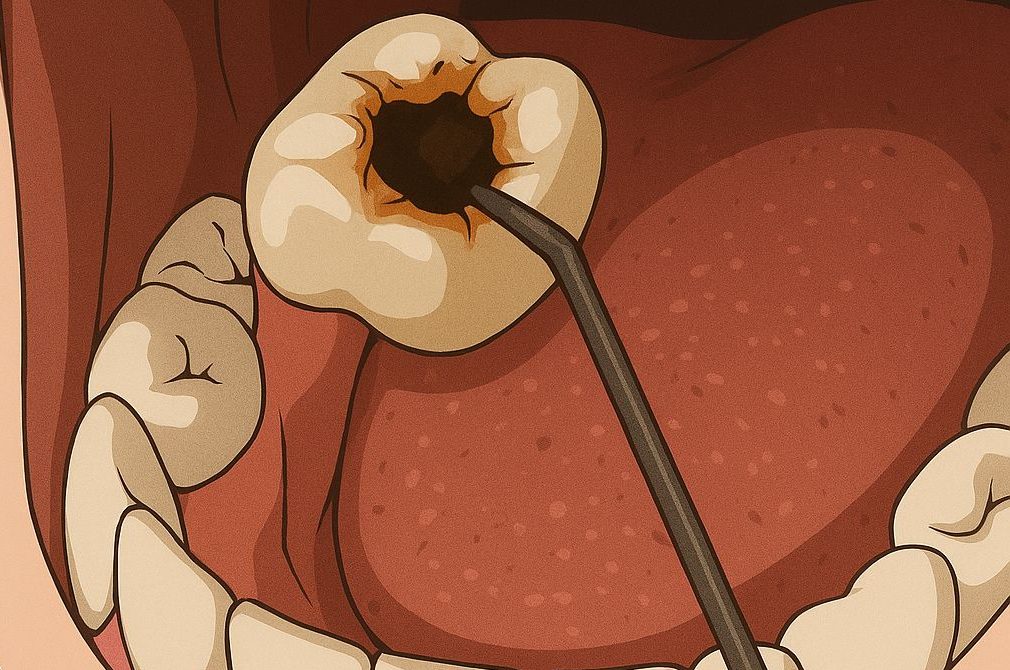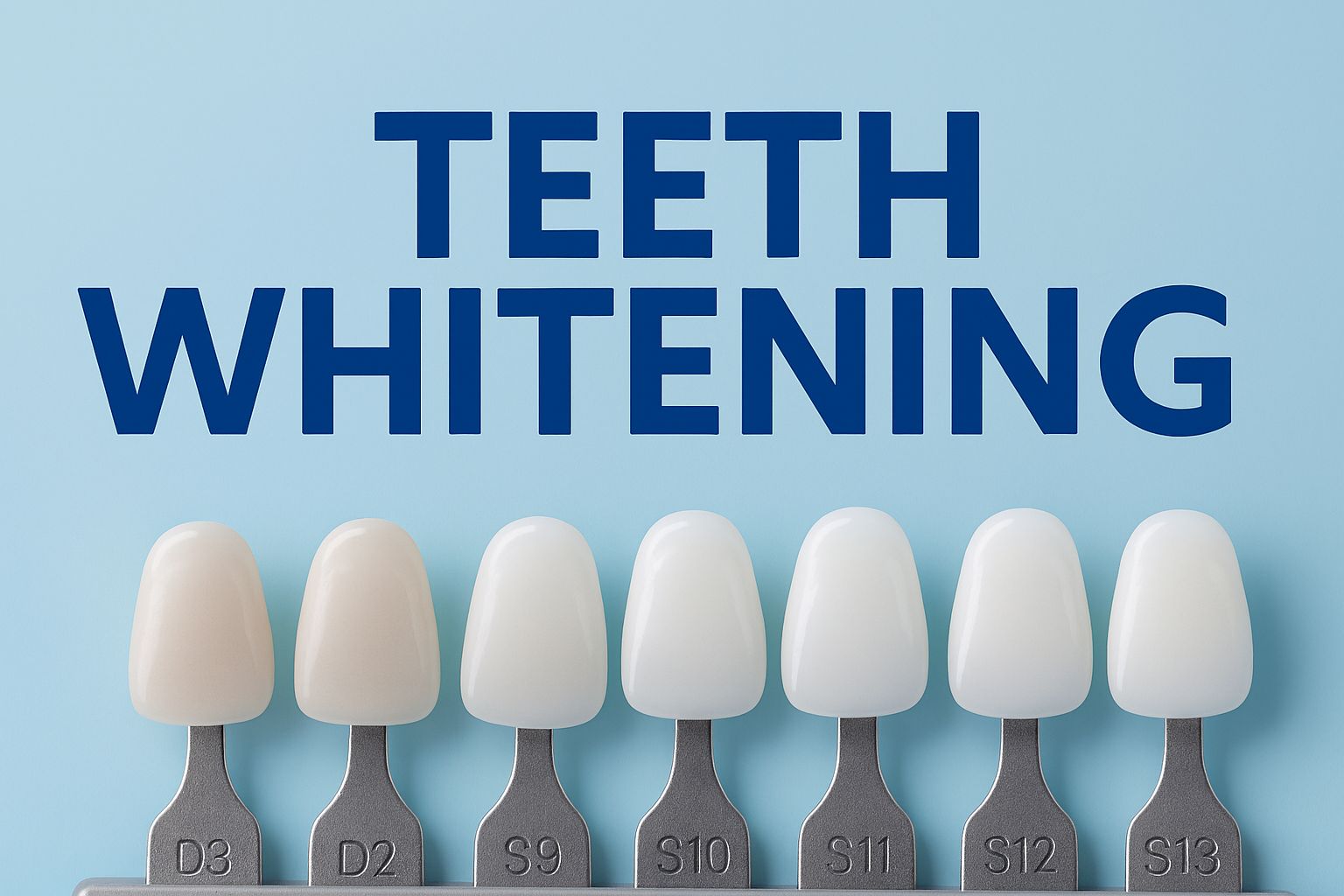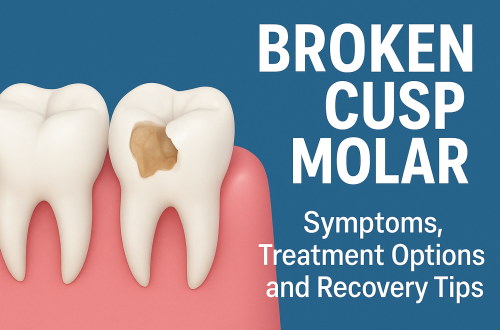Are you aware of the signs of an early cavity? Did you know that addressing tooth decay early can save you from pain and expensive dental bills? Many people wait until they feel discomfort to visit the dentist, but by then, the decay may have already reached deeper layers of the tooth. Understanding what an early cavity looks like, how it forms, and ways to reverse it is essential for keeping your teeth healthy and strong for life.
This guide brings together the latest dental insights and Singapore-specific information, helping you to identify, prevent, and treat early cavity teeth effectively.
What is an Early Cavity?
An early cavity, also called an initial carious lesion or “white spot lesion”, represents the first warning sign that the outer enamel of your tooth is losing minerals due to acid attack. Unlike a full cavity where the enamel breaks down and forms a visible hole, an early cavity remains beneath the surface and can still be healed. This process — known as remineralisation — occurs when minerals such as calcium, phosphate, and fluoride are redeposited into the enamel structure. It is the most critical moment to intervene.
In Singapore’s humid and snack-friendly environment, early cavities are more common than most people realise. Frequent sips of bubble tea, sweetened coffee, or isotonic drinks provide a constant source of sugar for bacteria to produce acid. These acids start dissolving enamel minerals little by little. Over weeks or months, you might notice a white, chalky patch near the gumline or along the edges of molars. That’s the earliest visual cue that an early cavity is developing.
Early Cavity Signs and Symptoms
Knowing the subtle signs of an early cavity can make all the difference. Here are the most common early indicators that your teeth are in the initial stage of decay:
- White, opaque or chalky spots that look dull compared to nearby enamel. These are typically seen near the gumline, between teeth, or on molars’ chewing surfaces.
- Mild sensitivity to cold drinks, sweets, or sour foods, even when there’s no visible hole.
- A slightly rough or dry texture on the tooth surface when it’s dry.
- Early staining on white spots — brownish or yellowish areas suggest that demineralisation is progressing.
- Persistent bad breath or metallic taste can also accompany early decay due to bacterial imbalance.
How Early Cavity Teeth Develop and Progress
The development of an early cavity follows a predictable biological process that starts with bacteria and sugar. When you eat or drink, the bacteria in dental plaque feed on sugars and carbohydrates, producing acid as a by-product. This acid gradually dissolves the enamel, creating a zone of mineral loss underneath the surface. If this cycle repeats too often — especially without enough fluoride — the damage accumulates.
Singapore’s modern lifestyle contributes to this process: many people snack frequently, sip sweet drinks over long periods, or brush hurriedly without flossing. Even supposedly “healthy” items like fruit juices or kombucha are acidic enough to weaken enamel. The early stage of cavity is the point where this damage can still be reversed with proper care.
| Stage | What You See/Feel | Typical Action |
|---|---|---|
| Stage 1 (Non-cavitated) | White or dull spots; mild sensitivity | Fluoride varnish, sealants, resin infiltration, diet control |
| Stage 2 (Enamel cavitation) | Small visible holes; food traps | Minimally invasive fillings, fluoride support |
| Stage 3 (Dentine involvement) | Brown, soft areas; pain on cold | Conventional fillings or pulp protection |
| Advanced Stage | Sharp pain, swelling, possible abscess | Root canal or extraction |
At stage 1 early cavity, mineral loss occurs but the enamel surface remains intact — this is the perfect time to act. By stage 2, once a hole forms, the damage becomes irreversible without a filling. Regular dental visits, every six to twelve months, allow professionals to catch early cavities using magnified imaging or laser detection before symptoms appear.
Can an Early Cavity Heal Itself?
Yes, an early cavity can sometimes heal naturally — but only under the right conditions. This depends on restoring balance between demineralisation (loss) and remineralisation (repair). Saliva plays a crucial role, as it neutralises acid and supplies calcium and phosphate. Fluoride enhances this process by forming a more acid-resistant mineral called fluorapatite. With consistent fluoride use, healthy saliva flow, and limited sugar exposure, an early lesion can re-harden.
Clinical evidence supports this: fluoride varnish and 1000+ ppm fluoride toothpaste are proven to reduce decay rates. Many dentists apply varnish for both adults and children, especially if early spots are seen on molars or near orthodontic brackets. Combined with dietary changes and improved brushing technique, this approach can reverse many early cavity teeth cases before fillings are required.
What Happens if an Early Cavity Goes Untreated?
When an early cavity is left untreated, the demineralisation continues until the surface breaks down. Once the enamel collapses, bacteria and debris can penetrate deeper, infecting the dentine and eventually reaching the nerve. Pain, swelling, or even tooth loss can follow. Ignoring a small white spot today may lead to root canal treatment tomorrow — something both costly and avoidable.
Untreated early cavities are one of the leading causes of school absenteeism among children and productivity loss in adults. The cost of prevention (fluoride varnish or sealant) is a fraction of restorative or surgical dental fees later on. Prevention is not only simpler but also more sustainable for long-term oral health.
How to Prevent Early Cavity
Preventing an early cavity starts with everyday habits. The tap water contains fluoride, but lifestyle factors like frequent snacking and stress can still increase risk. To maintain strong enamel, you need to combine professional care with daily discipline. Prevention is especially critical for children, teenagers, and people wearing braces or aligners, who are more prone to plaque accumulation.
Fluoride toothpaste remains your first line of defence. Use a pea-sized amount twice daily and spit, don’t rinse — this allows fluoride to stay on the teeth longer. Adults can also use mouthrinses containing 225 ppm fluoride for added protection. Between meals, drink plain water instead of sweetened beverages. For children, encourage water or milk as the main drink during the day, and limit sweet treats to mealtimes.
| Daily Habit | How to Do It | Why It Works |
|---|---|---|
| Brush twice daily with fluoride toothpaste | Pea-sized for children; full length for adults; avoid rinsing | Strengthens enamel and reverses early cavity lesions |
| Floss once daily | Slide gently between teeth in C-shape motion | Removes plaque hidden between teeth |
| Reduce sugary drinks | Limit to mealtimes; avoid sipping over long periods | Less acid exposure; fewer bacterial attacks |
| Visit dentist regularly | Every 6–12 months | Detects early cavity before symptoms |
To go further, your dentist may recommend professional fluoride varnish every six months, especially if you have a history of cavities. The key difference between an early cavity and a developed one lies in whether the enamel surface is still intact. If it hasn’t broken down yet, dental intervention can stop or even reverse it.
How to Treat Early Stage Cavity
When the lesion is confirmed as an early stage of cavity, treatment focuses on strengthening enamel and stopping bacterial activity. This can be achieved with a combination of professional and home strategies. Unlike traditional fillings, these approaches are non-invasive and pain-free.
Singapore’s dental clinics commonly use fluoride varnish, resin infiltration (e.g., ICON), and sealants to manage early cavities. Each method targets the lesion differently but shares the same goal — halting decay before structural damage occurs. For children, dentists might also apply silver diamine fluoride (SDF) if cooperation is limited or multiple lesions exist.
| Treatment | How It Helps | Evidence snapshot |
|---|---|---|
| Fluoride varnish | Deposits concentrated fluoride to stimulate enamel repair | Proven to reduce decay in children and adults |
| Sealants | Physically seals grooves; blocks bacteria and acids | Effective for molars with deep pits |
| Resin infiltration | Penetrates enamel to block porosities and improve appearance | Backed by clinical reviews and cosmetic results |
| Silver diamine fluoride (SDF) | Stops decay progression; stains lesions black | High caries-arrest success in primary teeth |
The success of stage 1 early cavity treatment also depends on patient cooperation. Maintaining daily fluoride exposure and consistent diet control ensures that remineralisation continues. In certain aesthetic cases, resin infiltration provides not only health benefits but also improves the tooth’s appearance by masking white spots.
For pricing transparency, private clinic fillings in Singapore typically range from S$75–S$327 per tooth, depending on complexity. However, if the lesion is detected at the early stage of cavity, you might avoid fillings entirely. Under CHAS subsidies, eligible Singaporeans receive partial support for dental services, helping reduce costs for families.
When necessary, NDCS and NUCOHS specialists also offer advanced micro-invasive procedures. Always consult a professional rather than attempting DIY remedies like charcoal toothpaste or home whitening kits, which may worsen enamel loss.
When to See a Dentist for Early Stage Cavity Treatment
In Singapore’s fast-paced lifestyle, it’s easy to postpone dental visits until pain sets in. But with early cavity teeth, waiting can make treatment more complex and expensive. You should see a dentist as soon as you notice persistent sensitivity, visible chalky spots, or difficulty cleaning certain areas. Routine scaling and polishing every six months allow dentists to identify lesions that may not yet be visible or painful.
High-risk groups include people with braces or aligners, children who snack often, older adults with dry mouth (xerostomia), and individuals on long-term medication. Pregnant women should also schedule a dental review, as hormonal changes can affect saliva flow and plaque accumulation. For these groups, preventive care and early cavity management are essential. If you’re looking for a trusted clinic, Penn Pacific Dental Center in Singapore offers comprehensive preventive and restorative care — from fluoride varnish treatments to minimally invasive solutions for early cavities.
- Same-week review: If you feel consistent sensitivity or notice dull white patches, book a check-up immediately.
- Urgent review: Seek immediate attention for sharp pain, swelling or pus, as these may signal infection.
- Preventive visit: Even without symptoms, maintain six-monthly appointments to catch early cavity signs invisible to the naked eye.
Singapore’s dental infrastructure supports both public and private options. CHAS clinics provide subsidies for basic procedures, and polyclinics can refer complex cases to NDCS or NUCOHS. You can also explore dental benefit plans offered by employers or private insurance that include preventive care packages. The main takeaway: don’t wait until an early cavity turns into a crisis — act early, and treatment will be simpler, faster, and far more affordable.
For parents, it’s especially important to observe children’s front teeth for early signs of decay. White lines near the gumline often indicate early childhood caries. Bringing them to a paediatric dentist early enables painless, preventive care using fluoride varnish or SDF rather than fillings. This builds a positive dental experience and prevents long-term fear of dentists. Penn Pacific Dental Center also provides gentle children’s dental check-ups with tailored fluoride protection, making it easier to manage early cavities in a comfortable setting.
Adults should also avoid underestimating early cavity symptoms such as subtle discomfort or visible dull patches. These minor signs can escalate quickly if left ignored, particularly among coffee drinkers or smokers whose enamel is constantly exposed to acid and heat. Regular professional cleaning and bite assessment at established practices like Penn Pacific Dental Center can identify plaque stagnation areas that encourage early cavity formation before they develop into deeper decay.
During a typical appointment, your dentist will:
- Examine your enamel under good lighting for white or opaque spots.
- Check between teeth using floss or radiographs for hidden lesions.
- Assess lifestyle risk factors — sugar frequency, dry mouth, diet.
- Recommend fluoride varnish, sealant, or dietary adjustments accordingly.
Many clinics now provide preventive dental packages that combine professional cleaning, fluoride application, and oral hygiene coaching in one session. These are ideal for anyone aiming to avoid early cavities or stop them from worsening. If cost is a concern, you can ask about CHAS or Medisave eligibility during booking. Most clinics, including Penn Pacific Dental Center, will clearly outline fees before treatment begins.
Remember: an early cavity is reversible — but only if you act during its early phase. Waiting until you feel pain or see dark holes usually means the enamel has already collapsed. Prevention and early diagnosis remain the most effective and cost-efficient forms of dental care in Singapore.
Conclusion
In conclusion, effectively preventing cavities hinges on early detection and consistent care to maintain strong enamel. By taking the right actions, you can sidestep the pain and costs associated with fillings or root canals. Regular check-ups are vital, especially for those wearing braces or noticing new white spots. Understanding how cavities form empowers you to take proactive steps, utilizing modern treatments like fluoride varnish as necessary. Every early cavity addressed means a tooth saved—ensuring your smile remains healthy, vibrant, and pain-free for years to come.
Frequently Asked Questions
1) Is water fluoridation in Singapore enough, or do I still need fluoride toothpaste?
Use both. PUB adds fluoride to tap water at low, safe levels to reduce decay, but brushing twice daily with at least 1000 ppm fluoride toothpaste delivers enamel-level protection directly where acids attack. This combination is recommended by local public resources and global guidance.
2) Can an early cavity really reverse without a filling?
Often, yes—if the surface hasn’t broken down. Clinical options like fluoride varnish and resin infiltration, alongside improved home care, can arrest and cosmetically improve early lesions. Your dentist will check if the tooth is still non-cavitated and recommend the best plan.
3) Are fillings covered by MediSave or CHAS?
MediSave is generally not claimable for non-surgical fillings (CPF Board policy). CHAS provides subsidies for selected dental services at participating clinics; amounts depend on card tier and clinical assessment. MOH has announced enhanced CHAS financing and fee benchmarks in 2025 to improve affordability and transparency.
4) My child has white lines near the gums—what should I do?
Those may be early childhood caries (white spot lesions). Book a paediatric dental visit. Treatments can include fluoride varnish or SDF (with staining trade-off) and coaching on diet/toothbrushing. Early care prevents pain, infection and future costly treatment.
5) How much does an early cavity filling cost in Singapore?
Fees vary by tooth position, size and material. Published private clinic ranges in 2025 show roughly S$75–S$327 per tooth; always confirm with your dentist after examination. Remember: stage 1 early cavity treatment without drilling is often possible—ask if you qualify.
References
- Smiles for Life Oral Health. Early ECC: White Spots. White spots/lines are the first clinical signs of caries. Link.
- National Dental Centre Singapore (NDCS). Clinic info & services. Link.
- National University Centre for Oral Health, Singapore (NUCOHS). Link.
- PUB: Drinking Water Quality PDF (typical NEWater values incl. fluoride <0.5 mg/L). Link.
- HealthHub (MOH). How Can I Prevent Tooth Decay in My Child? Recommends ≥1000 ppm fluoride toothpaste with age-appropriate amounts. Link.
- Cochrane Oral Health. Fluoride varnishes for preventing dental caries in children and adolescents. Link.
- SAGE Journal (regional guidance commentary). Recommending 1000 ppm fluoride toothpaste for caries prevention in children. Link.
- SingHealth. Early Childhood Caries—Conditions & Treatments. White chalky areas indicate enamel demineralisation. Link.
- PUB. Drinking Water—Why is fluoride added? Fluoridation since 1957; levels below 0.7 mg/L and within WHO guidelines. Link.
- Ministry of Health, Singapore. Water fluoridation safe, with dental benefits. Link.
- International Dental literature (East Asia). Recommendations on Topical Fluoride Usage for Caries Management (2024): ≥1000 ppm toothpaste; SDF arrest rates. Link.
- ScienceDirect (Umbrella review). Effectiveness of resin infiltration in caries inhibition & aesthetics. Link.
- MDPI Review. Effect of Resin Infiltration on Enamel (2021). Link.
- American Dental Association. Silver Diamine Fluoride—key points incl. staining of arrested lesions. Link.
- i.Dental. Dental Price List in Singapore—filling range S$75.60–S$324 (2025 page). Link.
- True Dental Studio. Dental Price List Singapore (2025)—filling range S$98.10–S$239.80. Link.
- Official CHAS page. Dental Subsidies for selected procedures at participating clinics. Link.
- MOH Press Release (1 Sep 2025). Enhanced financing support for CHAS dental procedures. Link.
- CPF Board. Can I use MediSave to pay for non-surgical dental treatments? Generally no—fillings are not claimable. Link.










